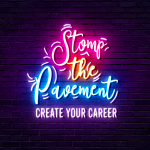When it comes to your resume, details are everything. If an employer has a stack of 100+ applications (which, in this job market, is likely) and needs to cut the pile down to the 10 best, they’re going to start looking for any small reason to cut a person. To avoid being cut for something small, make sure you’re using the perfect fonts on your resume.
When I would review resumes in Career services, one of my fellow reviewers would always snicker when he overheard me mention (and thoroughly explain) how to choose a font for your resume. In his mind, it was something small and easy to choose (Times New Roman forever). In my mind, it was a detail that could set someone apart in an overcrowded job market.
Despite the snickering (which, by the way, always made me laugh too), I would carefully explain to my clients what I’m about to explain to you when it comes time to choose fonts for your resume.
So, let’s get down to business to defeat the fonts! Get it? It’s fine, let’s move on.
What kind of job?
Choosing fonts for your resume depends first and foremost on what kind of job you’re applying for. In some industries, like business, finance, and accounting, there are very strict rules for resumes. Traditionally, those jobs require Times New Roman, size 12 (or 11, if you’re daring), plain font.
For industries without such strict guidelines, you have some room to play with your fonts. For most positions, I’d say you could use a mix of two different fonts, serif and sans serif (more on that next). In creative industries, like graphic design, art, or some forms of marketing, you can be even more flexible and add colors and backgrounds to your fonts and resumes. That, of course, depends on the position and company you’re applying for- so I wouldn’t jump into a creative resume unless you’re sure it’s the best option for you.
The Perfect Mix
Earlier I mentioned serif and sans serif fonts- now, don’t get overwhelmed if you have no idea what that means! I’m going to break it down for you.
Serif fonts are one with the little “feet” coming off each letter– think, again, Times New Roman- if you look closely, there are small lines hanging off the ends of the letters. Those lines are called serifs- if a font has them, it’s considered a serif font.
Sans serif fonts are the ones without feet– like Arial or the fonts on this website. So, if a font doesn’t have the extra feet on its letters, it’s a sans serif font.
What does this mean for your resume?
Combining a serif font with a complementary sans serif font (both of which are simple and easy to read) creates an excellent balance on your resume.
Serif fonts are best for your name and the headings on your resume- this adds emphasis without making your resume too cluttered (a block of serif font has the tendency to feel more overwhelming because of all the extra feet).
Use a sans serif font for the body text of your resume– this will make all of your important information and descriptions appear clean and easy to read.
If you’re feeling daring, you could also use a 3rd font just for your name, to give it an extra mmph!
Finding Fonts
While it’s perfectly acceptable to use the fonts on your computer, you could also branch out and download some new fonts! I have a lot of fun searching through fonts and experimenting with different combinations.
My favorite place to look for fonts is dafont.com, since they’re all free for personal use!
Just remember that, above all, the fonts you use have to be readable and easy on the eyes. If the fonts you choose make something difficult to read or are just an eyesore, it’s NOT a good choice for your resume.
The font you use for your resume depends on the job you’re applying for- if it’s in an industry with strict resume norms, then a standard Times New Roman is best. If there’s more flexibility in your industry, then a serif font (with feet) for the headings used with a complimentary sans serif font (without feet) in the body text is the perfect combination! You can totally use the fonts already on your computer, or you can try out some new ones from the web- just make sure they’re easy to read!
Ready to stop relying on your resume? Grab my guide on the 10 best strategies to network with confidence and transform your job search!







